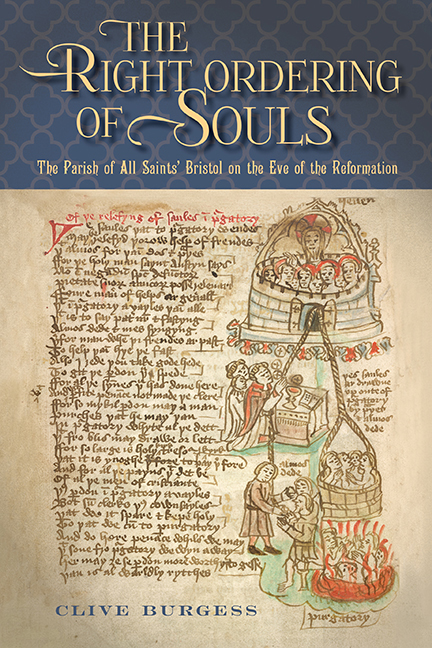Book contents
- Frontmatter
- Dedication
- Contents
- List of illustrations
- Acknowledgements
- Miscellaneous Frontmatter
- Abbreviations
- Notes
- map
- Part I For the increase of the divine service
- Part II All Saints’, Bristol, and its parishioners
- Part III Commemorating the dead
- Part IV Leaders and administrators
- 8 ‘He procured, moved and stirred’: Clergy as mentors
- 9 ‘Well willed men’: Leaders, managers and parishioners
- Coda
- Part V Ordering the parish
- Appendices
- Bibliography
- Glossary
- Index
- Miscellaneous Endmatter
8 - ‘He procured, moved and stirred’: Clergy as mentors
from Part IV - Leaders and administrators
Published online by Cambridge University Press: 05 May 2018
- Frontmatter
- Dedication
- Contents
- List of illustrations
- Acknowledgements
- Miscellaneous Frontmatter
- Abbreviations
- Notes
- map
- Part I For the increase of the divine service
- Part II All Saints’, Bristol, and its parishioners
- Part III Commemorating the dead
- Part IV Leaders and administrators
- 8 ‘He procured, moved and stirred’: Clergy as mentors
- 9 ‘Well willed men’: Leaders, managers and parishioners
- Coda
- Part V Ordering the parish
- Appendices
- Bibliography
- Glossary
- Index
- Miscellaneous Endmatter
Summary
Although the notion has been discredited that clergy and laity must inevitably have been at loggerheads before the Reformation, we nevertheless still have a tendency to treat priests as axiomatically set apart. In some obvious respects this was true; but, if anything, the evidence surviving for All Saints’ tends to accentuate how constructively the clergy worked with parishioners to secure the shared benefit of the community. We have already explored the collaboration between Richard Haddon and John Gyllard, prior of the Kalendars, and also considered how Maurice Hardwick first lobbied for and then defended Agnes Fyler's endowment. It has emerged, moreover, that parishioners in All Saints’ possessed a degree of spiritual understanding that speaks well of the instruction received from their clergy, either formally from the pulpit and at confession, or informally by example in and around the parish. While synodal legislation determined certain responses – for instance, by defining the laity's responsibilities as churchwardens – the role that parish priests played and the instruction they no doubt offered influenced both individual and communal conduct. The clergy not only exercised leadership by example but also carefully assimilated their efforts with those they exhorted from their parishioners. Although their words may now be lost, the All Saints’ archive permits us to retrieve aspects of their behaviour, revealing how they dovetailed their efforts with those elicited from their flock. Parishioners, as we will see, clearly respected their clergy, and specifically sought their personal assistance. If their estate set clergy apart, this by no means led to disengagement; the following elaborates on the nature of their involvement.
The vicars and priests that have been good doers: Clergy as role models
Appraising the part played by the clergy in parish affairs is normally difficult because much of the evidence on which we rely was produced by and for the laity; it treats the clergy, at best, in a glancing manner. For all their detail, churchwardens’ accounts, for instance, served specific purposes: to enable parishioners to keep close track of the ‘parish stock’ – be it money or equipment – entrusted to the wardens, and to prove the discharge of duties incumbent on the laity. The clergy's activity lay mainly beyond their remit. But, once again, the All Saints’ archive furnishes materials offsetting this shortcoming.
- Type
- Chapter
- Information
- 'The Right Ordering of Souls'The Parish of All Saints’ Bristol on the Eve of the Reformation, pp. 261 - 281Publisher: Boydell & BrewerPrint publication year: 2018

